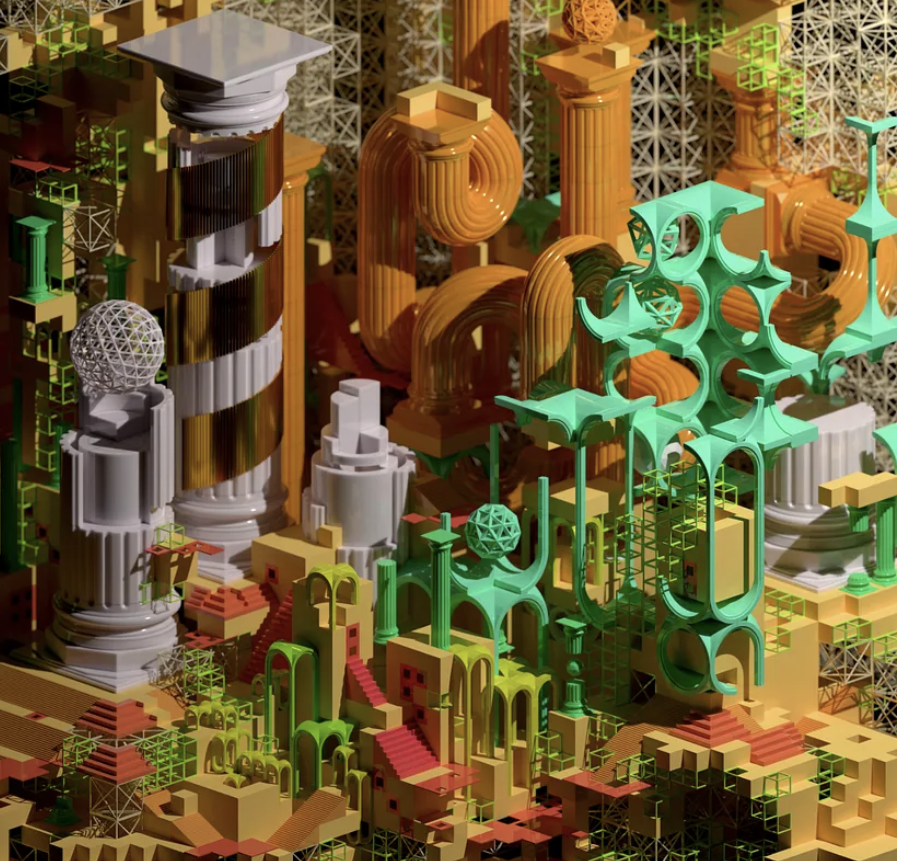“All of my buildings are inside out”
This interview was first published on medium.com, January 18, 2023
Loading New Architecture by untitled, xyz. Minted on SuperRare in August 2022
by Anna Seaman
Architectural design in ‘real life’ can require 100s of iterations prior to deciding the final structure. The resulting architecture must make sense logistically, fit the allocated budget and is obviously bound by physics and gravity. However, when Kirk Finkel practised as an architect, he always felt the unrealised imaginings were the most exciting, where the most stakeholders were engaged and creativity flourished; tossing them aside was to sacrifice artistry for practicality.
In 2016, working as an urban designer, Finkel presentated on the future of decentralised design using blockchain technology to practise architecture as art, where the product was a result of a conversation, rather than a prescriptive “black box process”. This was the first hook to pull him away away from IRL architecture and into metaverse ‘artchitecture’
“I was excited by the fact that you could practise something creatively alongside the growth of a new technology and learn from both. Discussions and reactions between the two and the exchange of ideas, was fascinating and fulfilling to me,” he says.
Gamified by untitled, xyz. Minted on SuperRare in February 2021
However, his journey began years before. In 2011, Finkel graduated with a Bachelor’s degree in architecture from Cornell University and, with a group of friends, travelled to Berlin to create art as architects. “We were 22 years old and wanted to explore what collective art and architecture looked like. So, we created a collective [called ‘Hither Yon’] and did many experiments to create joint compositions. That shaped a lot of my thinking going forward.”
Removing the self was something that continued to drive him and in 2017, he pursued a solo practice, though never considered it a lone endeavour. He began his first blockchain project on a now defunct social platform called Steem. The idea was to start with a blank canvas and build a collaborative town. He asked collaborators to submit images of their home towns and he started 3D modelling architectural elements: windows, archways, staircases — building them modularly creating a vernacular that was familiar but collaged from references all over the world.
Not long afterwards he adopted his pseudonym — untitled, xyz — derived from the basis of 3D programs, which is usually a default scene named ‘untitled’ and a 3D grid centred on a series of lines identifying an ‘X, Y and Z’ axis. “I didn’t want to use my name,” he explains. “I started anonymously with an urge to experiment, and a hope that my work on its own would resonate. I think that the culture of anonymity really clicked with me in the early days. It felt that people from all over the world could identify and empathise exclusively through artwork, not physical identity, or other biases. This different mode of connecting and creating with people was/is exciting, virtual, but super real.”
And as he continues to contemplate the future of imaginary cities, they are collaborations between user and creator, somehow familiar yet also, a brand-new discovery. He feels a freedom from the limitations of traditional architecture and creates abstract, impossible and otherworldly art spaces. “So much of architecture and physical galleries that we experience are locked in and the art is trapped — heavily curated, design and carefully articulated. But for me, all of my buildings are inside out. I place art on the walls that face out, there are no entrances or exits and no one way to explore. This gives the user the agency to decide their own path and how to experience the art.
“In the metaverse, a build should be something that challenges everything you know and expect about a building.”
Monument of Errors by untitled, xyz. Minted on SuperRare in January 2022
Two of his most recent pieces — listed on SuperRare — play on these notions of nostalgia and futurism. Referring to his abstraction of the classical column in Monument of Errors, he says: “In real life, classical columns are symmetrical and predictable and follow clear direction. In this artwork, I want to pull from that nostalgia and introduce playful exploration of new territory within the building. There is a glimpse of a city the breaking of rules and logic, which helps people to rethink — I like to pull on that thread of symbols and create a new order,” he says.
The artwork was part of a group show about imaginary metropoles and an ode to Italo Calvino’s Invisible Cities. The caption of the artwork says: “The resulting architecture is a diagram of dead branches, of futures not achieved.”
Now a practising metaverse architect and an exhibiting artist (by now we know that for Finkel, the two are symbiotic) untitled, xyz is currently engaged in designing the first 33 MOCA ROOMs, released by the Museum of Crypto Art to give agency to a community to decide what a museum can look like and function in a metaverse environment unbound. by physical axioms.
“One of the things I love about the space is that it is more participatory and more engaged and MOCA ROOMs embody that,”
And as for the future, untitled, xyz remains simultaneously hopeful and fearful. “I feel the virtual realm should be more collaborative with the real world — I believe it can help us inform the growth of urban planning and development of neighbourhoods and is a powerful tool. I absolutely do not believe we should abandon the real world entirely.”
Kirk Finkel, a.k.a untitled, xyz




